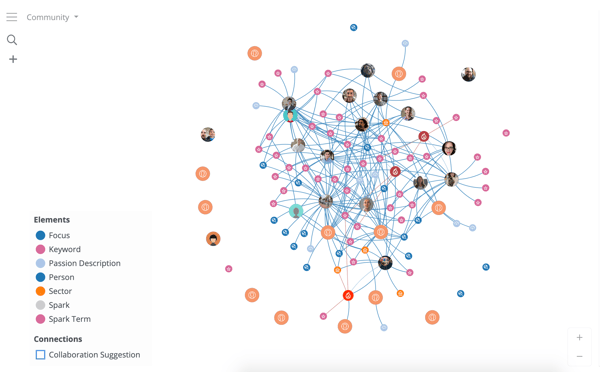
At some point in your life, you’ve found yourself describing a project you’ve worked on to a friend. They interject, “I’ve done something similar to this before,” and go on to describe a field or skill you didn’t know they were familiar with. You’ve just uncovered some dark assets about your friend: a set of skills or knowledge that were only discovered due to an accidental trigger.
This can be problematic when it comes to group projects, whether you’re working with an existing team or you’re putting one together. The people and tools available to you are limited to those you are aware of or those cataloged in scattered directories and lists across the internet. There are far more dark assets than known assets.
In order to build and branch teams more effectively and innovatively, we need two things: a map and a compass. We build a map so that we can see the dark assets. We equip ourselves with a compass to guide us towards relevant assets.
We like to use a network diagram as our map.

We use these networks to map people and resources. People could be resources, but we tend to distinguish people from inanimate assets, like publications or technologies.
We dub these people and resources “entities.” Every entity has “attributes” that describe it. For instance, people have interests, skills, passions, publications, and projects associated with them. A publication has a date, an author list, an abstract, and key terms. As I list these out, imagine how connections would form in the network between entities across shared attributes.
In the network below, you can see some shared connections on technology, for-profit, javascript, music, and sustainability and unique perspectives of Education, Social Good, cello, art, and AI.
In addition to the map, we need the equivalent of a compass - finer tools to navigate this environment. These tools illuminate the entities that bring the most complementary skills to our team composition.
- Suggestion algorithms allow us to find teammates that add complementary differences to our team. This is helpful for deciding which entities we should focus on in our map.
- Artifact-recording tools allow us to document and track ideas inside documents and see how they connect.
- Termscapes are a richer map for navigating the content that our community generates or studies. They are generated by analyzing unstructured text about a collection of entities and arranging those entities into a landscape of their terms.
Using these tools allows us to remove the accidental nature of discovering important resources. What tools do you use or wish you had to approach this problem?
Comments